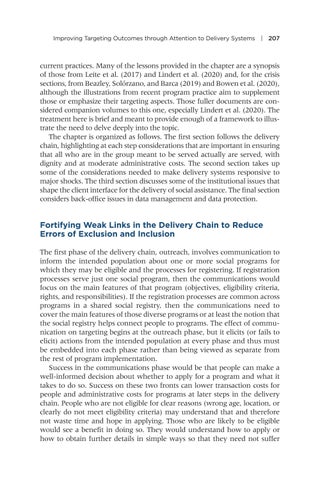Improving Targeting Outcomes through Attention to Delivery Systems | 207
current practices. Many of the lessons provided in the chapter are a synopsis of those from Leite et al. (2017) and Lindert et al. (2020) and, for the crisis sections, from Beazley, Solórzano, and Barca (2019) and Bowen et al. (2020), although the illustrations from recent program practice aim to supplement those or emphasize their targeting aspects. Those fuller documents are considered companion volumes to this one, especially Lindert et al. (2020). The treatment here is brief and meant to provide enough of a framework to illustrate the need to delve deeply into the topic. The chapter is organized as follows. The first section follows the delivery chain, highlighting at each step considerations that are important in ensuring that all who are in the group meant to be served actually are served, with dignity and at moderate administrative costs. The second section takes up some of the considerations needed to make delivery systems responsive to major shocks. The third section discusses some of the institutional issues that shape the client interface for the delivery of social assistance. The final section considers back-office issues in data management and data protection.
Fortifying Weak Links in the Delivery Chain to Reduce Errors of Exclusion and Inclusion The first phase of the delivery chain, outreach, involves communication to inform the intended population about one or more social programs for which they may be eligible and the processes for registering. If registration processes serve just one social program, then the communications would focus on the main features of that program (objectives, eligibility criteria, rights, and responsibilities). If the registration processes are common across programs in a shared social registry, then the communications need to cover the main features of those diverse programs or at least the notion that the social registry helps connect people to programs. The effect of communication on targeting begins at the outreach phase, but it elicits (or fails to elicit) actions from the intended population at every phase and thus must be embedded into each phase rather than being viewed as separate from the rest of program implementation. Success in the communications phase would be that people can make a well-informed decision about whether to apply for a program and what it takes to do so. Success on these two fronts can lower transaction costs for people and administrative costs for programs at later steps in the delivery chain. People who are not eligible for clear reasons (wrong age, location, or clearly do not meet eligibility criteria) may understand that and therefore not waste time and hope in applying. Those who are likely to be eligible would see a benefit in doing so. They would understand how to apply or how to obtain further details in simple ways so that they need not suffer


